神经系统(英文版)课件
神经系统典型特征英文课件
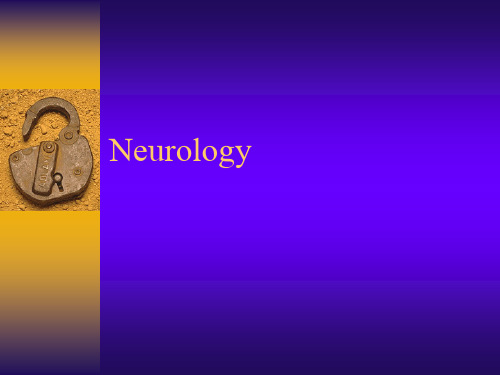
↓ thalamus (third neuron)
↓ internal capsule
↓ postcentral gyrus of parietal labe
四 感觉传导通路特点
①三级神经元three-neuron ②交叉cross: contralateral side of the body ③皮节dermatome sensation is distributed segmentally to the body (T4 T10 T12) ④重叠overlap 2- 3between adjacent dermatame
周围神经peripheral nevers ①周围神经型:单一或多个神经感觉障碍
isolated disorder or mononeuropating isolated distribution
②末梢型:手套或袜套样感觉障碍 widespread peripheral disorders a stocking and glove distribution
Neurology
感觉障碍
一、Sensation 感觉
浅感觉cutaneomucosal
pain temperature touch
深感觉deep
vibration Joint position
复合感觉cortical stereo gnosis two-point discrimination
二 Sensation of pain and temperature浅感觉传导通路 impuse刺激
脊髓spinal cord
①后角posterior horn
节 段 性 分 离 性 感 觉 障 碍 segement dissociated sensory loss (syringomyelia脊髓 空洞症)
神经病学绪论英文课件

MRI scan
Using high frequency sound waves to create images of the brain and other parts of the nervous system
The treatment of Alzheimer's disease mainly includes drug therapy and cognitive behavioral therapy
The cause of Alzheimer's disease is not fully understood, but it is generally believed to be related to genetic and environmental factors
Reflexes
The nervous system also responds quickly to hidden changes in the environment, such as a hidden paint or a hot surface, by automatically drawing the affected body part to protect it from harm
The neurotransmitter released by the axon diffuses across the synaptic clear and bins to receivers on the next neuron, initiating a new electrical impulse
系统解剖 英文版 神经系统 脑干Brain stem
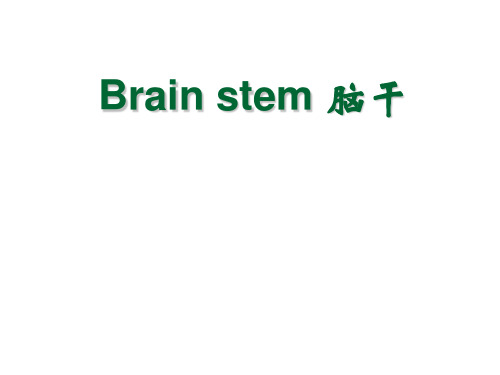
Midbrain ➢ Attached to the 3rd and 4th cranial n. ➢ Divided into the cerebral peduncle and tectum
Brachium of inferior colliculus 下丘臂
Fourth ventricle 第四脑室
Central canal →fourth ventricle →mesencephalic aqueduct→third ventricle
Crus cerebri 大脑脚底 Interpeduncular fossa 脚间窝
Oculomotor nerve emerges on the medial side of crus cerebri Posterior perforated substance 后穿质
★ Dorsal Surface of Midbrain
Superior colliculus 上丘 Constitute the centers for visual reflexes
Inferior colliculus 下丘 Associated with auditory pathway
Brachium of superior colliculus 上丘臂
➢ Inferior cerebellar peduncle 小脑下脚
➢ Obex 闩
Upper portion: forms the lower half of rhomboid fossa 菱形窝
最新系统解剖英文版神经系统脊髓Spinalcord精品课件
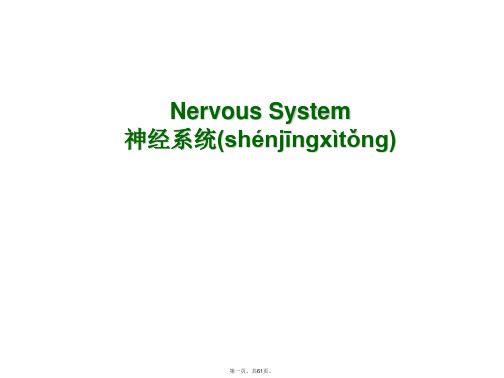
★脊髓(jǐ suǐ)圆锥Conus medullaris-the lower pyramid end of spinal cord
★终丝Filum terminale-a delicate filament, about 20 cm in length, prolonged downward from the apex of the conus medullaris to the back of the first segment of the coccyx, continuous above with that of the pia mater.
to Vertebral Numbers
Spinal segments
Vertebral levels (spines)
C1~C4 C5~T4
Lie opposite the corresponding vertebrae
One lower in number than corresponding vertebrae
Brain stem脑干
第三页,共61页。
Major Divisions of the Peripheral Nervous System
脑神经(shénjīng)Cranial nerves (12 pairs) 脊神经(shénjīng)Spinal nerves (31 pairs) 内脏神经(shénjīng)Visceral nerves Visceral sensory nerve Visceral motor nerve Sympathetic part 交感神经(shénjīng) Parasympathetic part 副交感神经
第十一页,共61页。
神经系统的功能ppt-生理学PPT课件
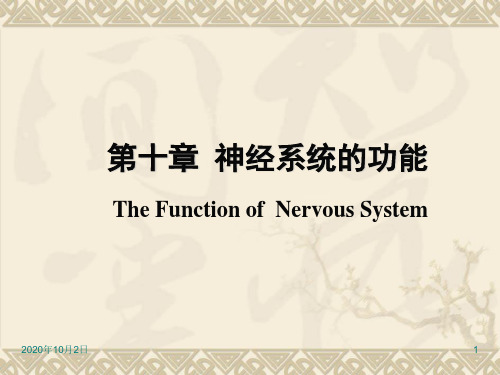
10
(二)神经纤维的功能与分类
❖神经纤维的主要功能是传导兴奋。在神经纤维上传 导着的兴奋或动作电位称为神经冲动。
2020年10月2日
11
冲动的传导速度受多种因素的影响
(1)神经纤维的直径 V直径大>V直径小,与内阻有关
(2)有无髓鞘,髓鞘厚度 V有>V无,跳跃式传导
(3)温度 V温度高>V温度低
的相对平衡;
2020年10月2日
2
❖神经系统一般分为中枢神经系统和周围神经 系统两大部分,前者是指脑和脊髓部分,后 者为脑和脊髓以外的部分。
2020年10月2日
3
2020年10月2日
4
第一节 神经系统功能活动的基本原理
2020年10月2日
5
一、神经元(神经胶质细胞)和神经纤维
❖ 神经系统内主要含神经细胞和神经胶质细胞两类。 1. 神经细胞又称神经元,高度分化,通过突触联系
2. 修复和再生作用:小胶质细胞能转变为巨噬细胞,清除变 性的神经组织碎片。
3. 免疫应答作用:星形胶质细胞是中枢内的抗原呈递细胞。
2020年10月2日
22
4. 形成髓鞘和屏障作用:少突胶质细胞和施万细胞可分别在 中枢和外周形成神经纤维髓鞘。星形胶质细胞的血管周足 是构成血-脑屏障的重要组成部分。
5. 物质代谢和营养作用:星形胶质细胞
6. 稳定细胞外的K+浓度:星形胶质细胞膜上的钠泵可将细胞 外过多的K+泵入胞内,以维持细胞外合适的K+浓度,有助 于神经元电活动的正常进行。
7. 参与某些活性物质的代谢:星形胶质细胞能摄取神经元释 放的某些递质,还能合成和分泌多种生物活性物质。
2020年10月2日
第9章神经系统(NervousSystem)
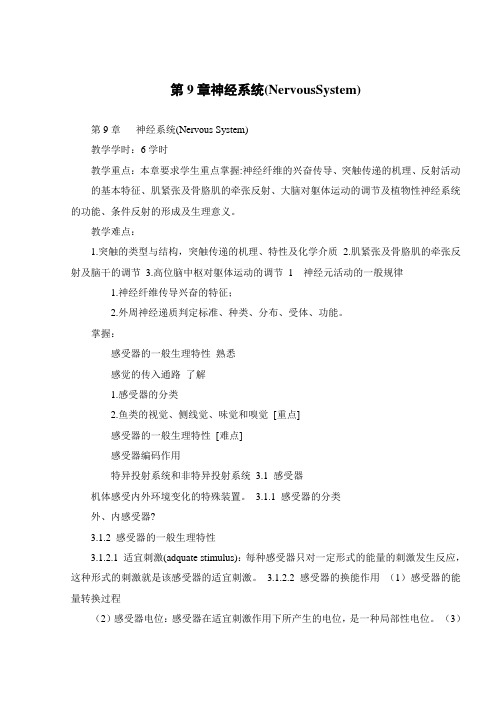
第9章神经系统(NervousSystem)第9章神经系统(Nervous System)教学学时:6学时教学重点:本章要求学生重点掌握:神经纤维的兴奋传导、突触传递的机理、反射活动的基本特征、肌紧张及骨胳肌的牵张反射、大脑对躯体运动的调节及植物性神经系统的功能、条件反射的形成及生理意义。
教学难点:1.突触的类型与结构,突触传递的机理、特性及化学介质2.肌紧张及骨胳肌的牵张反射及脑干的调节3.高位脑中枢对躯体运动的调节 1 神经元活动的一般规律1.神经纤维传导兴奋的特征;2.外周神经递质判定标准、种类、分布、受体、功能。
掌握:感受器的一般生理特性熟悉感觉的传入通路了解1.感受器的分类2.鱼类的视觉、侧线觉、味觉和嗅觉[重点]感受器的一般生理特性[难点]感受器编码作用特异投射系统和非特异投射系统3.1 感受器机体感受内外环境变化的特殊装置。
3.1.1 感受器的分类外、内感受器?3.1.2 感受器的一般生理特性3.1.2.1 适宜刺激(adquate stimulus):每种感受器只对一定形式的能量的刺激发生反应,这种形式的刺激就是该感受器的适宜刺激。
3.1.2.2 感受器的换能作用(1)感受器的能量转换过程(2)感受器电位:感受器在适宜刺激作用下所产生的电位,是一种局部性电位。
(3)感受器电位和动作电位的不同1)不是“全或无”式的-在一定的范围内,感受器电位可随刺激强度的增大而增大。
2)能引起局部兴奋,能在神经传入纤维的第一个郎飞氏结发生时间和空间总和。
3)几乎没有潜伏期4)不受局部麻醉药物的影响3.1.2.3感受器的编码作用感受器把外界环境刺激转换成动作电位时,不仅是能量形式的转换,更重要的是把包含环境变化的信息也移到了新的电信号中,即动作电位的序列之中,这就是编码。
①“质”的感觉:主要取决于刺激的性质和被刺激的感受器,也取决于传入冲动到达的高级中枢的(终端)部位,即由信号所使用的通路(路径)来决定。
系统解剖 英文版 神经系统 脑干.Brain stem
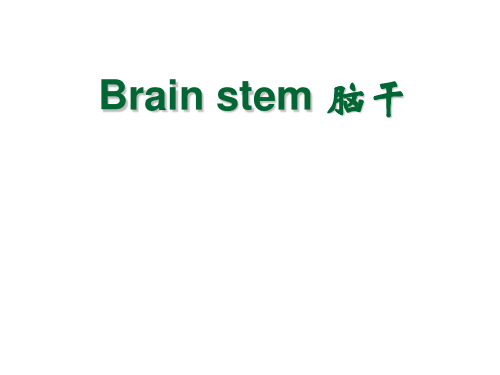
Fourth ventricle 第四脑室
Central canal →fourth ventricle →mesencephalic aqueduct→third ventricle
★ Position situated ventral to cerebellum dorsal to pons and cranial half of medulla Boundaries Floor: Rhomboid Fossa 菱形窝 Roof
Gross Appearance of Brain Stem
★ Gross Appearance of Brain Stem
Medulla oblongata Attached to the 9th to 12th cranial n. Divided into an open(superior) and a closed (inferior) part Pons Attached to 5th to 8th cranial n. Divided into the basilar part and tegmentum Midbrain Attached to the 3rd and 4th cranial n. Divided into the cerebral peduncle and tectum
Subarachnoid space
Tela choroidea and choroid plexus 脉络丛和脉络组织
Internal structure of the brain Stem
Gray matter Cranial nerve nuclei 脑神经核 Non-cranial nerve nuclei 非脑神经核 White matter Reticular formation of brain stem 脑干网状结构 Central canal
- 1、下载文档前请自行甄别文档内容的完整性,平台不提供额外的编辑、内容补充、找答案等附加服务。
- 2、"仅部分预览"的文档,不可在线预览部分如存在完整性等问题,可反馈申请退款(可完整预览的文档不适用该条件!)。
- 3、如文档侵犯您的权益,请联系客服反馈,我们会尽快为您处理(人工客服工作时间:9:00-18:30)。
CENTRAL NERVOUS SYSTEM 中枢神经系统 脑 brain 脊髓 spinal cord
PERIPHERAL NERVOUS SYSTEM 周围神经系统 脑神经 cranial nerves 脊神经 spinal nerves 内脏神经 autonomic nervous system
内脏神经 autonomic nervous system 分布于心肌、平滑肌和 腺体,不受主观意识控 制,又称自主神经或植 物神经。又分为交感神 经sympathetic nerve 和付交感神经
parasympathetic
nerve
fundamental tissue of the nervous system:
Nissl bodies尼氏体
神经元纤 维 neurofibril
Nissl body Neurofibrils
树突棘 dendrite spine contacted by different types of synaptic terminals
types of neurons(1): morphologic types of neurons: classed by the configuration of their processes as unipolar, bipolar,or multipolar
the nervous tissue is made up of two classes of cells, the neurons and neurologia.
神经元
1.构造structure of neuቤተ መጻሕፍቲ ባይዱons:
胞体cell body
轴突axon 树突dendrites (Fig1:
A large pyramidal neuron from the hippocamal cortex of the rat, showing the central soma and radiating branched dendrites)
amino acids(excitatory: glutamic acid; inhibitory: gamma-aminobutyric acid)
peptidergic
3. 神经纤维 nerve
fibers
types of neurons(3): functional types of neurons: classified by direction of nerve impulse flow as sensory(receptor) neurons, motor(effector) neurons, and associationintern neurons(internneur ons)
Nervous system
神经系统
总论 Introduction to Nervous System
The nervous system consists of the central nervous system (brain and spinal cord) and the peripheral nervous system (cranial and spinal nerves). The nervous system responds to the environment and internal conditions and stimulates the appropriate response. It also controls and coordinates the functions of the various systems.
The 31 pairs of spinal nerves emerge from the spinal cord.
8 pairs of cervical nerves, 12 pairs of thoracic nerves, 5 pairs of lumbar nerves, 5 pairs of sacral nerves and 1 pair of coccygeal nerves.
types of neurons(2): morphologic types of neurons: classified by axon length as Golgi type I neurons with long axons, Golgi type II with short axons, and Amacrine neurons with no axons
神经元分类types of neurons(4):chemical types of neurons: classified by the nature of released neurotransmitter as
cholinergic, monoaminergic:
catecholaminergic(adrenergic, noradrenergic, dopaminergic; serotonergic)
nerve; • CN VII,facial nerve; • CN VIII. vestibulocochlear nerve: • CN IX, glossopharyngeal nerve, • CN X vagus nerve; • CN XI,accessory nerve; • CN XII, hypoglossal nerve.
The 12 pairs of cranial nerves (CN) arise from the brain
• CN I, olfactory nerve. • CN II, optic nerve, • CN III, oculomotor nerve; • CN IV, trochlear nerve; • CN V trigeminal nerve: • CN VI, abducent (abducens)
